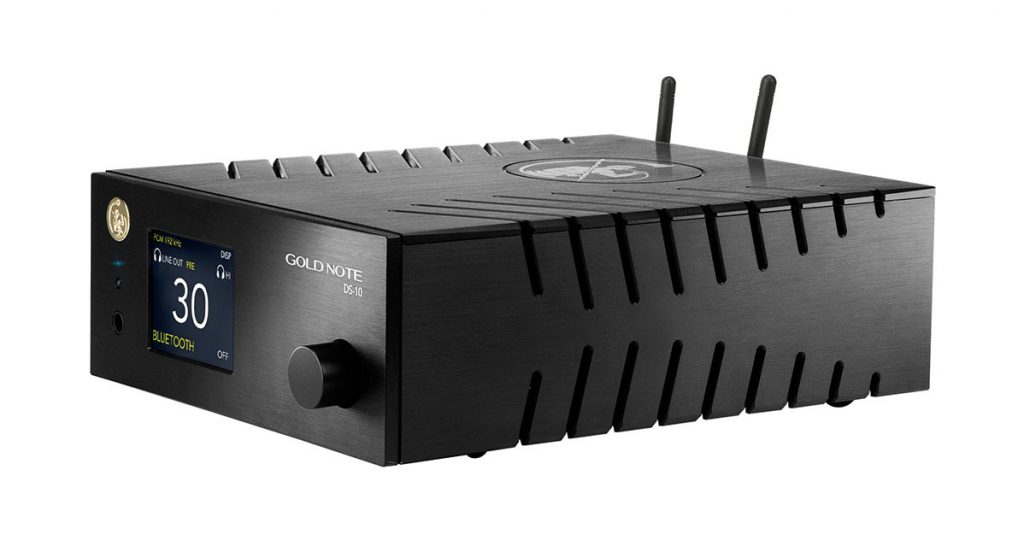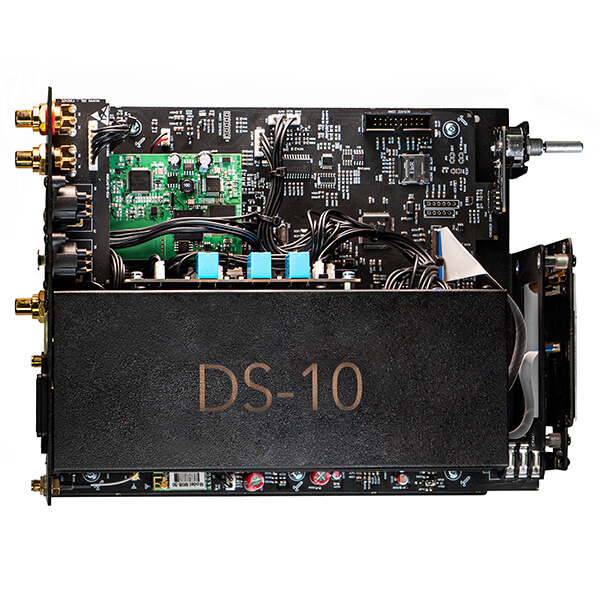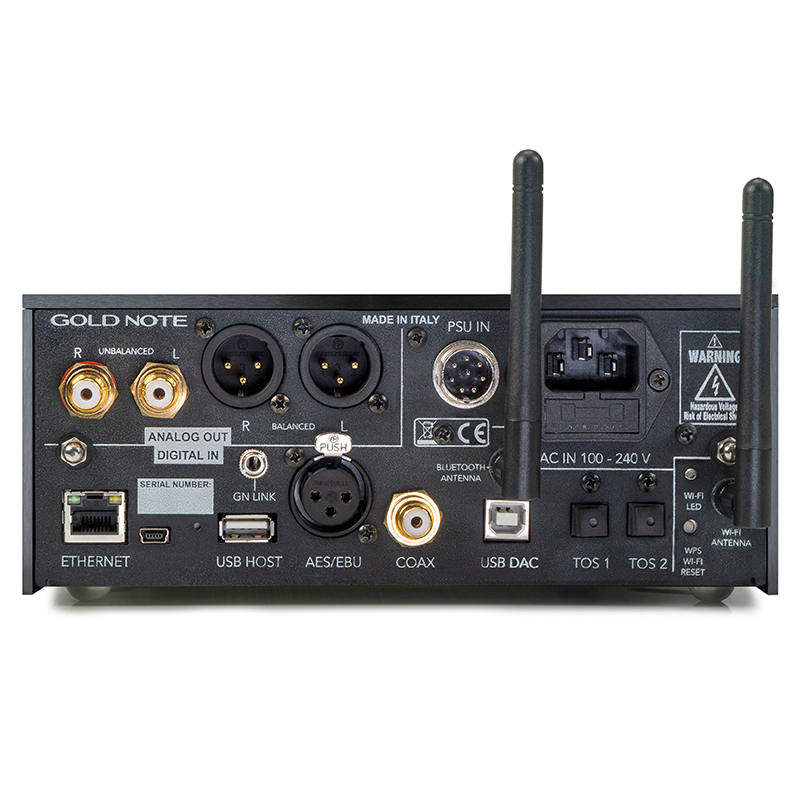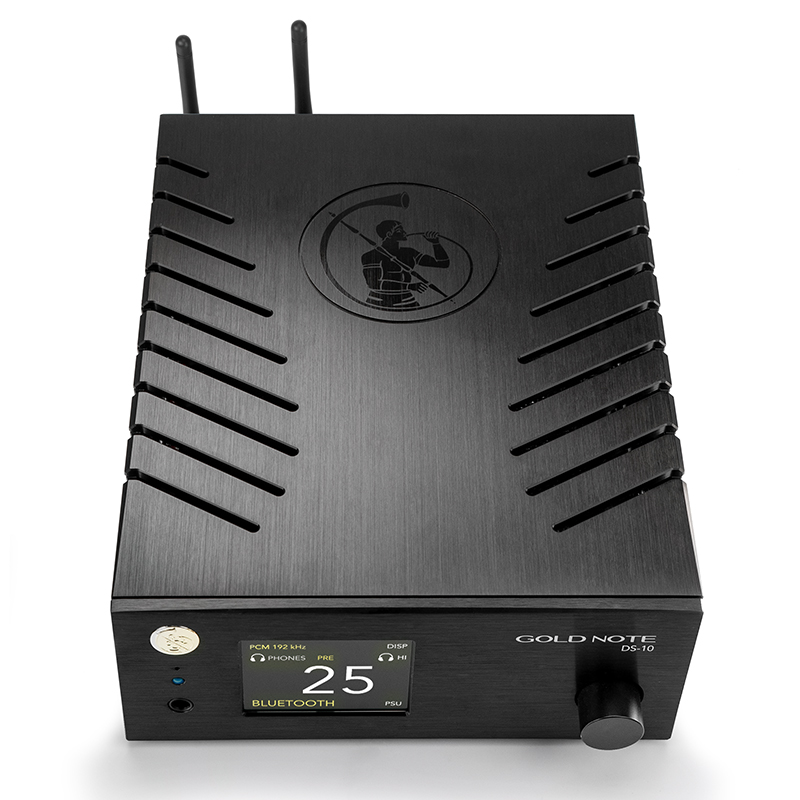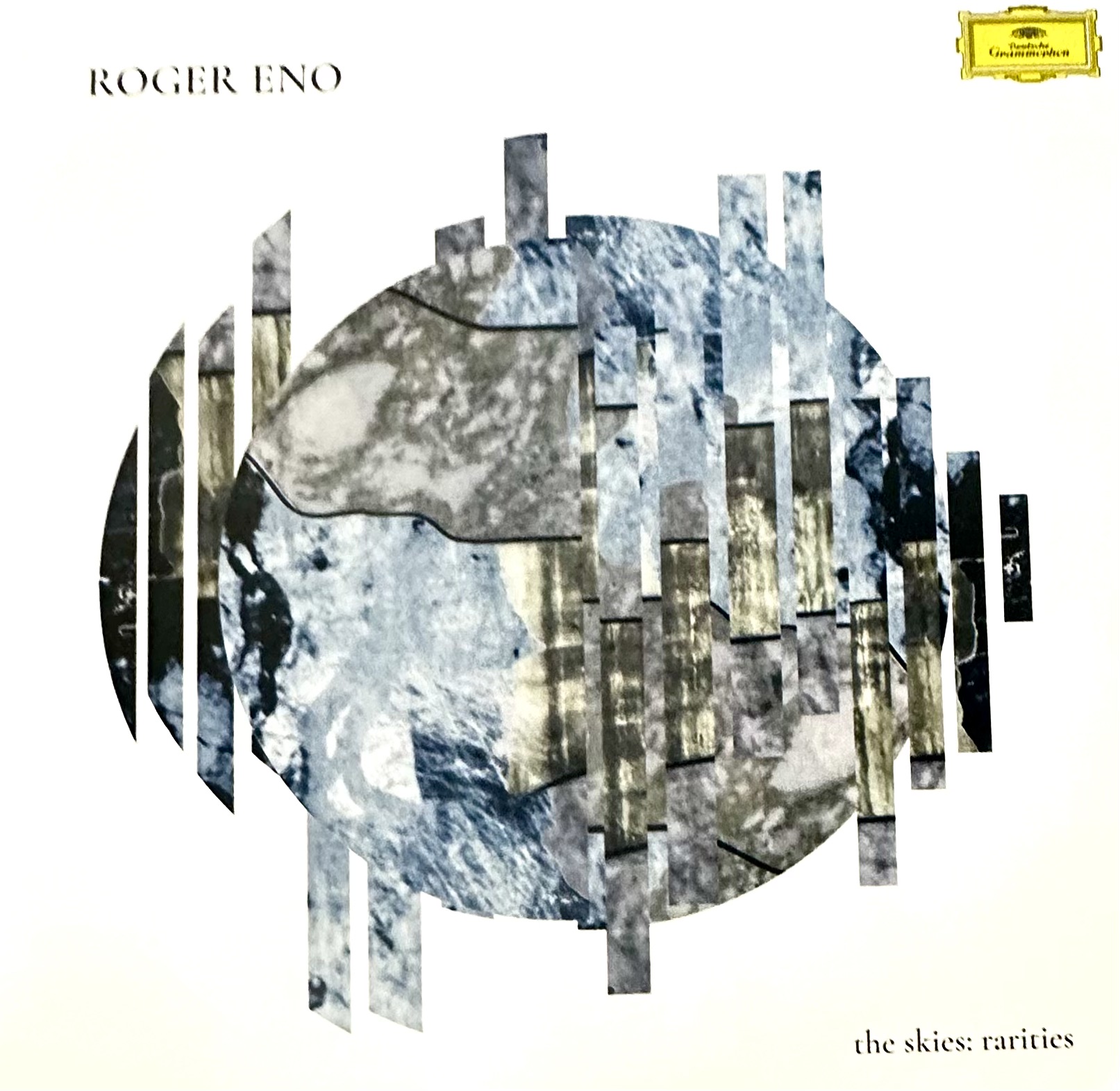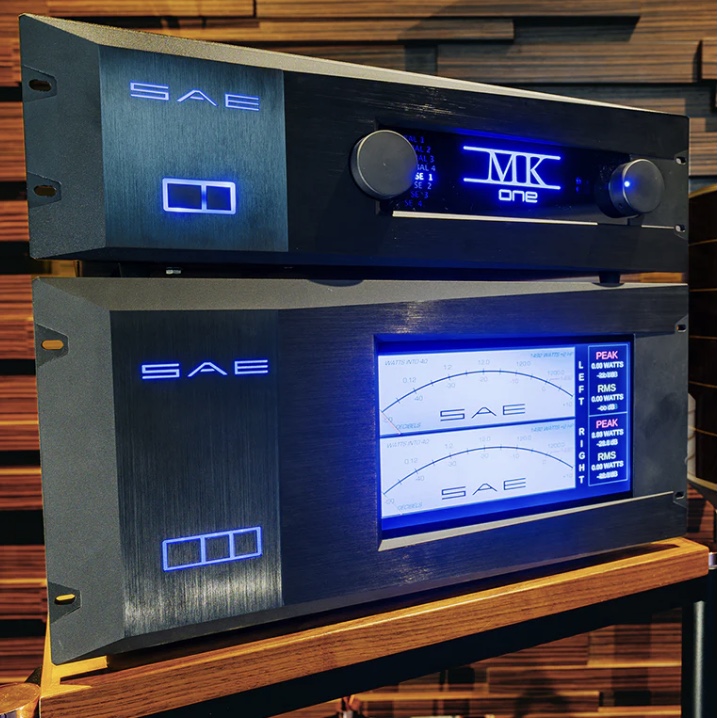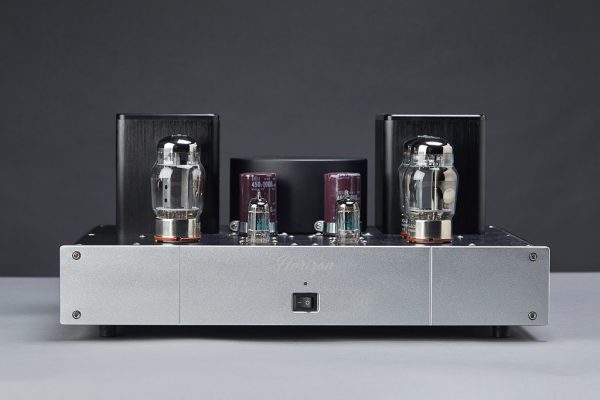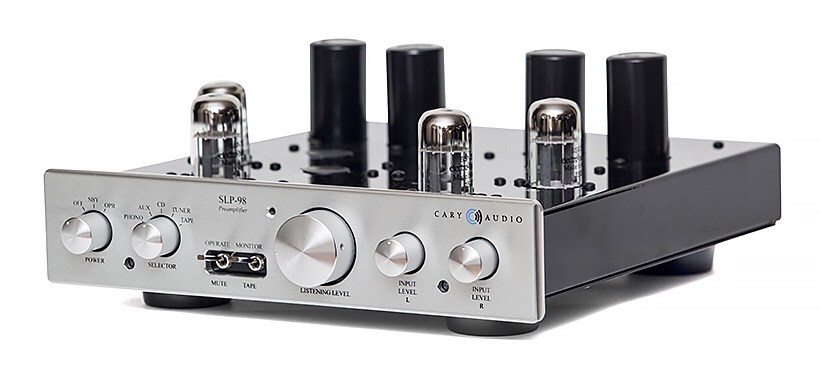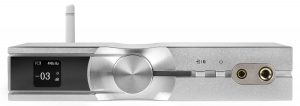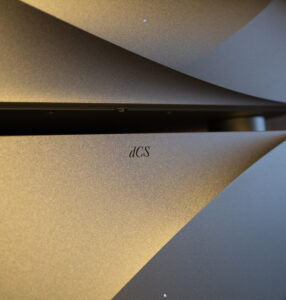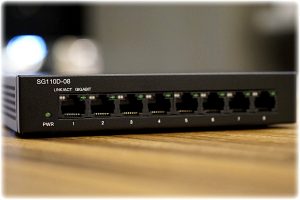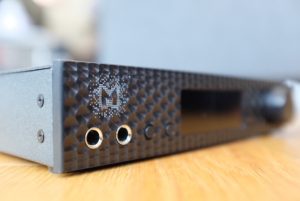Digital Streaming is a relatively new sound source for me. Call me old fashioned, curmudgeonly, resistant or even a snob, but I have been seriously engrossed in vinyl and transferring a bunch of it to reel to reel for over a year, so my streaming endeavors have been at a minimum comparatively speaking. I certainly have not had a streamer with the capability, or the quality of this unit. There! How is that for an honest disclosure? Seems I should have been a bit more attuned to this segment because I have had an astonishingly eye opening experience with the Gold Note DS-10.
The DS-10 is so much more than a simple DAC. (He said in his best Rowan Atkinson impression from Love Actually. If you do not get the reference look for Rowan Atkinson, Love Actually, on YouTube. It will all come into focus in the flashiest of flashes)
The DS-10 according to Gold Note, "unites digital and internet connectivity with the purity of Gold Note High-End audio performances to create an elegant and innovative product." We will delve into that claim and see just what this compact Italian beauty can do. Come along for the ride.
The DS-10 is a compact unit measuring 200mm W x 80mm H x 260mm D (8.2" x 3.28" x 10.66"), and packs a whole host of features in its small chassis.
The DS-10 is the latest generation of DAC using the brand new AKM chip, the AK4493, which allows resolution in PCM format up to 768kHz/32-bit, and is DSD up to DSD512. In addition to converting the the audio signal, it is also capable of sending it directly to a power amplifier, or a set of powered speakers like the Kantos I reviewed earlier. This makes it a very versatile analogue line preamp. Now to sweeten the pot, as it were, in addition to those features it is also a latest generation streamer and a high performance headphone amp that features two selectable sensitivity levels to drive any type of headphones in the best of all possible ways.
As a streamer, the DS-10 can handle and be connected to a variety of digital sources via cable through the USB-B input to connect to a computer. Not only that, but it can connect via Ethernet, coaxial, AES/EBU, TOS optical input for CD players or TVs. The full compliment is 1 coax, 2 optical, 1 AES, 1 USB-A, 1 USB-B inputs, and of course RCA outputs and Bluetooth connectivity.
The DS-10 is equipped with a very vision friendly 2.8" TFT display to monitor the functions of the unit, and adjacent is the single control knob that controls all the functions of the unit. The unit comes with a remote too, and this makes it really easy to control from your listening position. Very, very convenient. The DS-10 also features an easy to set up and operate Apple iOS and Android proprietary software to control from your smart phone or tablet device. Entirely made in Italy, it is the Ferrari of DAC/Streamers!
Thanks to the unique and innovative Gold Note modular design the DS-10 will be able to optionally drive a special external inductive power supply (PSU-10 EVO) to effectively enhance the overall performance of the unit. While I was not supplied with this option, I did include a picture of it, and would imagine it to be a good addition if it in fact did provide enhanced performance.
Although a bit repetitive here are the specs neatly summed up in one place for those who lust after these details:
MAIN FEATURES
- D/A Converter AKM AK4493 PCM up to 32bit/768kHz and DSD512 native
- Streamer Network Player PCM and DSD
- Frequency response: 20Hz-20kHz +/-0.1dB
- THD – Total Harmonic Distortion: 0.001% max Signal to Noise ratio: -125dB
- Dynamic range: 120dB
- Output impedance RCA/XRL: 50Ω
- Preamp Stage Volume Control: enabled/disabled
DIGITAL INPUTS
- 1 Ethernet LAN and Wi-Fi DSD64 (DoP) Resolution: PCM up to 24bit/192kHz
- 1x RCA S/PDIF coaxial PCM asynchronous up to 24bit/192kHz
- 2x TOS-optical PCM asynchronous up to 24bit/192kHz
- 1 COAX asynchronous up to 24bit/192kHz
- 1x AES/EBU balanced PCM asynchronous up to 24bit/192kHz
- 1x USB-A port to feed USB flash memories, FAT32/NTFS formatted playing DSD64 and PCM up to 24bit/192kHz
- 1 x USB-B asynchronous up to DSD512 and PCM up to 32bit/384kHz
AUDIO OUTPUTS
- Line output level (fixed): stereo RCA @ 1Volt, XLR @ 2Volt and 6,3 mm headphone jack on the front panel
NETWORK CONNECTIVITY
- LAN/WLAN (WiFi): 802.11b/g via RJ45 10/100Mbps socket - Bluetooth 5.0
STREAMING HIGH QUALITY
- Bluetooth 5.0, AIRPLAY, ROON Ready, TIDAL e MQA via Tidal, QOBUZ, SPOTIFY e SPOTIFY Con- nect, DEEZER, V-TUNER
SUPPORTED AUDIO FORMATS (NETWORK)
- AIFF (.aif, .aiff, .aifc)
- ALAC
- WAV (.wav) packed/unpacked
- FLAC
- MP3
- DSF, DFF
- Apple Lossless
- OGG
- Monkey's
- (IMPORTANT: UPnP server must support DSD streaming in order to stream DSD files).
- SUPPORTED MEDIA SERVERS
- All UPnP / DLNA / Roon
DIMENSIONS AND WEIGHT
- 200mmW|80mmH|260mmD - 4kg
- FINISHES
- Brushed anodized Aluminum available in Black, silver or gold
- POWER
- Mains supply: 100V to 240V, 50/60Hz Multiple Transformer proprietary power supply Power consumption: 30W
- EXTERNAL POWER SUPPLY
- PSU-10 EVO: external inductive multi transformer power supply
That is a lot of detailed engineering and scientific information. What does it all mean to the layman who wants an all in one unit that can drive a line stage system? To someone that wants a whole lot of great features in a compact, easy to use (once you read the instructions and take the time to learn the unit), and very flexible unit built to a high standard that has not only great use ability, but also exceptional aesthetics? Perhaps we should get into that now.
I was very impressed when I unboxed the unit. It was compact, but a very stoutly built piece of kit. The review unit came in the silver finish and mated well to the white and silver theme of most of my gear. I have owned three Gold Note items. The Tuscany cartridge, the Pamphili phono preamp, and the DSS30 Blacknote (another Gold Note sub brand) USB player. All of their products have an immediate feel of quality. The D-10 is available in either silver, black, or a champagne gold finish (very elegant looking).
The unit is very audio shelf friendly and easy to set up. The remote control has a solid feel to it, and works rather well in day to day use. It also controlled the unit from just about anywhere in my roughly 33 x 17 foot room, and even the adjacent kitchen and family room.
The compact unit has a very easy to use multi function knob and 2" x 2" display that is equally easy to navigate. It becomes rather intuitive in short order. The knob functions as a selector switch and volume control.
I first set up the DS-10 as a strict streamer from my Tidal account and my iPad Pro. Throughout the use in this function, the unit was flawless. The music stream was hi-def, and at times it was almost reminiscent of vinyl, in terms of no fatigue, no digital edge, or graininess. A might bit of improvement over my Audioengine streamer. Then again, the DS-10 is so much more than just a streamer. (Again sounding like Rowan Atkinson in Love Actually as the salesman taking forever to wrap a present). As stated, this is a line stage preamplifier.
Most of the review time was spent using it as a streamer running my Tidal playlists. I did also connect it to my computer via USB B connect. What was most noticeable to me was what little difference in quality there was from Bluetooth streaming and the USB connection. To be perfectly honest, I really could not discern any quality difference, which means one of two things; my ears are shot (testing does not indicate that), or the Bluetooth streaming quality is such a high quality the difference was so negligible as to be below hearing thresholds. I am sticking with the latter. I found that I preferred the Bluetooth streaming for a number of reasons; most importantly it offered superior flexibility with devices and being untethered. And I found it much easier, especially when going between devices. iTunes and Tidal on separate devices allowed quick changing between sources and music formats. While little of that has to do with long term use, and more review convenience, I found it to be a very handy ability.
Living with the unit was an absolute joy. It is easily navigated and was left on the entire time it was in my system. (I have a thing about leaving digital items on most of the time, so I leave them on.) The remote worked very well, moving from function to function and as such, was always an easy task.
I have very specific review playlists for digital listening that includes female jazz vocals, instrumental jazz, male vocals, vicious rock (lots of bass, heavy drums and wicked dynamic shifts), and classical.
This time around it was male vocals that started things off. One of the most engaging tracks is Willie Nelson's "Stardust" from the album of the same name. This album, originally released in 1978, was a collaboration between Nelson and Booker T. Jones, and one of the most enjoyable Nelson albums I have listened to. This track in particular, at least in my perspective, shows the incredible ability of Willie to take a song outside of the country genre he is most noted for, and make it his own. This track is stark in accompaniment, and focuses on his vocal skills and his prowess as a guitar player who is comfortable in most any genre.
The track features drums, bass, guitar, and organ provided by Booker T himself, and sweetly underscores Willie's vocals originally recorded when he was a young 61 year old crooner. The vocal control is astonishing. The DS-10 transmitted the the shifts in his range with absolute perfection. There is a longing built into the song by the very nature of the lyrics, but what the DS-10 captures is the emotion and longing in Willie's delivery. This song meant something to him on a personal level, and that just comes through with so much melancholy and heart. There is a breathiness and the sibilants are palpable. He simply paints this beautiful picture of love lost and mourned. The gentle cymbal strikes are clear, and the decay are free from being artificially choked off. The stick hitting the side of the snare drum has a very present whack that is slightly muffled by the loose grip on the drumstick. It is that restrained performance that comes through so clearly that impressed me. Additionally, the guitar work of Nelson and Jody Payne adds a lilting touch to the performance. The plucking of the strings is so clear and defined, you can easily distinguish the touch between fingers and pick. That is something most guitar players pick up when listening and learning songs, especially guitar solos like that in "Stardust."
Each player is also represented in a gorgeous soundstage. The depth, width, and height left me feeling that Willie was right in my room standing dead center—it was very real in the presentation.
On Captain Beyond's track "Sufficiently Breathless," title track from the 1973 album of the same name, the theme of guitar driven music continued. For those who are not aware of who Captain Beyond is, well it is a collaboration of a number of musicians headed by Lee Dorman. If that name does not ring a bell then think back to the late 60s and a little obscure song called "In-A-Gadda-Da-Vida." The album was the biggest selling album of 1969. No small feat. Lee was the bassist for Iron Butterfly. Captain Beyond was an effort that saw Lee, along with a number of up and coming musicians including Bruce Hornsby on organ, Reese Wynans on keyboards and guitar, Larry Reinhardt on bass, Brian Glascock on drums, and Rod Evans on vocals, along with Lee playing bass, guitars and offering vocals.
The title song is an acoustic guitar driven exercise in minimalist chord structure. It is a song underplayed by sparkling steel string acoustic guitars at its core, with a smattering of fuzzed electric guitar. The guitars were crystal clear, and the string attack and decay were front and center without stealing the performance. Rod and Lee's vocals are so precise and insistent, especially in the more monotone passages. Anyone who has ever sang or tried to sing in a band will tell you that is one of the toughest things to do in a single performance, let alone with multiple vocalists. That part of the performance was presented so well when coming through the DS-10.
On the track "C'est di Bon," a collaboration between Diana Krall, Thomas Dutronc, and Iggy Pop from the album Thomas Dutronc Frenchy, you get a snappy Bossa Nova type groove with the three artists trading vocals. What is interesting about the track is the extreme range and difference in the vocal deliveries is diverse, one from the other, it almost defies description, and the logic in choosing this trio! The vocal delivery is so spot on, and gives each performer the requisite space around their vocals that they just seem to float in the sound stage, and the transition from Krall's creamy crooning to Pop's low level growl it is an amazing set. Dutronc's vocals fill the gap between the two, and Rocky Gresset's guitar works well with Krall's piano to underpin the track at just the right level.
The clarity with which the track came through the DS-10 let me enjoy each performer in their own position on the soundstage, and the air around each let you enjoy the recording as if it was a intimate live performance in my my room. The combination of drums and double bass providing the rhythm section benefited from the same precise placement on the sound stage, with the requisite space and air also added to the sense of a small quintet no more than 6 feet in front of me, with another 15 feet behind the edge of the stage giving the depth a palpable realism.
No matter what kind of music I threw at the DS-10, it handled it without fuss or drawing attention to itself. Compared to some other streamers I have used, the DS-10 seemed in a class by itself. Images were more holographic and soundstage was the best I have experienced with any streamer I have used.
Another interesting aspect of this unit is how it performs as a preamp. I took the DS-10 out of my regular system and used it in a smaller system to drive a pair of Quicksilver KT88 mono blocks, connected to a set of Sonus Faber Electa Amator monitors. I fed the DS-10 tunes through my iMac, and through Bluetooth from two other sources. I was hugely impressed with how the DS-10 functioned as an all inclusive preamp. If I had one complaint or criticism it would be to equip the unit with two RCA inputs to allow a couple of analogue sources to easily mate with it. I wanted to sample how it would deal with a turntable, or my reel to reel. I imagine it would have been lovely, considering how well it processed digital signals, but that was not possible. I would gladly give up a couple of the digital inputs to have some analogue inputs. That being said, the DS-10 did everything else I asked of it, and did it with exquisite competency and minimal to zero fuss. Everything that ran through the DS-10 sounded wonderful. If you are of the mindset to have a compact and easily navigated digital system, the DS-10 should be at the top of the list to audition.
As a headphone amp it was truly wonderful. I do most of my critical listening into the late night hours, and out of respect for my spouse I used the headphone amp numerous times during its time in the system. I have a couple of units that I use for that purpose, and the DS-10 matched my Grant A-534 300B unit, which shocked me to no end. The sound lacked any and all digital edge or harshness when listening through my Grado Headphones. I can honestly say if I was back in my apartment dwelling days, or moved into a condo in the near future, this would easily be at the top of my list for a full function headphone amp. Airy, detailed, and neutral is how the headphone experience was for me. That says a lot for this little unit. I was a unable to do a side by side evaluation between the Grant and the DS-10, but I am pretty sure it was not only the equal, but probably slightly superior in overall features and usability.
I have a friend who, after spending a day listening in my system, immediately purchased a DS-10 as the preamp for his smaller, yet extremely wicked little system, and has done nothing but tell me that it transformed the entire system. He has a very discerning ear. Listening to this junior system before and after the addition of the DS-10, I can say there is no comparison in the before and after listening experience. It took his system up two steps at a minimum. That is not a small improvement.
As I stated at the opening of this review, it has been an astonishing, eye opening experience, and the single best endorsement I could make about the Gold Note DS-10 here is that if the current budget allowed, this unit would not be leaving my system, and as soon as finances ease a bit I am going to purchase one of these units! It is that simple. It is often a bit disappointing to have to send items back at the end of the review, but you simply cannot afford, or should I say I cannot afford to purchase every little thing that comes my way, and usually I bid a fond farewell to something realizing if I didn't, I would have to exit retirement and go back to work to keep myself out of financial ruin! That being said, this will be a very different experience, and I will be none too happy to let it go. Hopefully, this will be a short term situation. For the rest of you, if you are shopping for a unit that can provide all this one can, then you should seek one out ASAP. Even if you use it strictly as streamer, it is a superior product. Yeah buddy come get you some! You won't be disappointed!
DS-10 DAC/Preamp/Streamer
Retail: $2995
Gold Note




